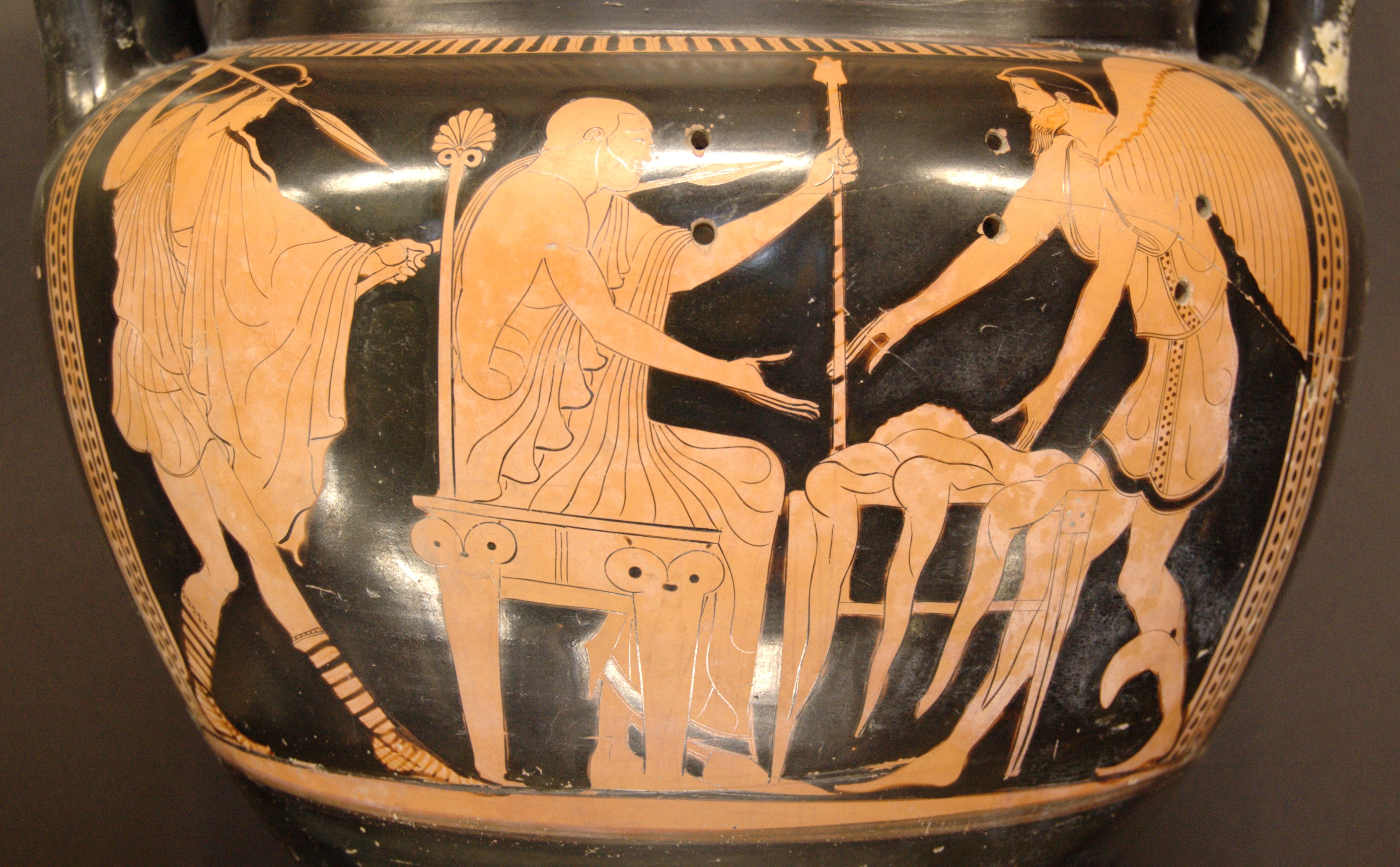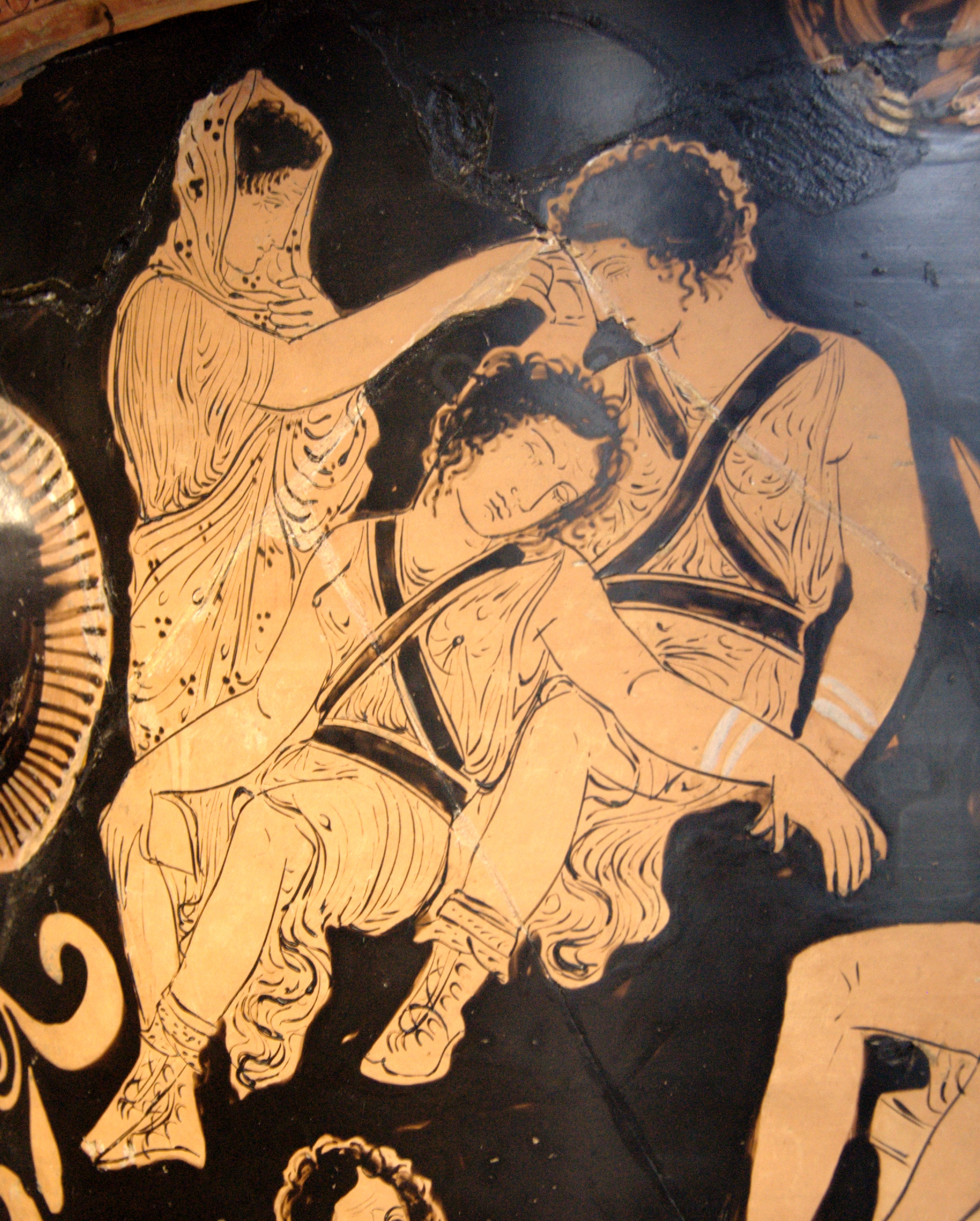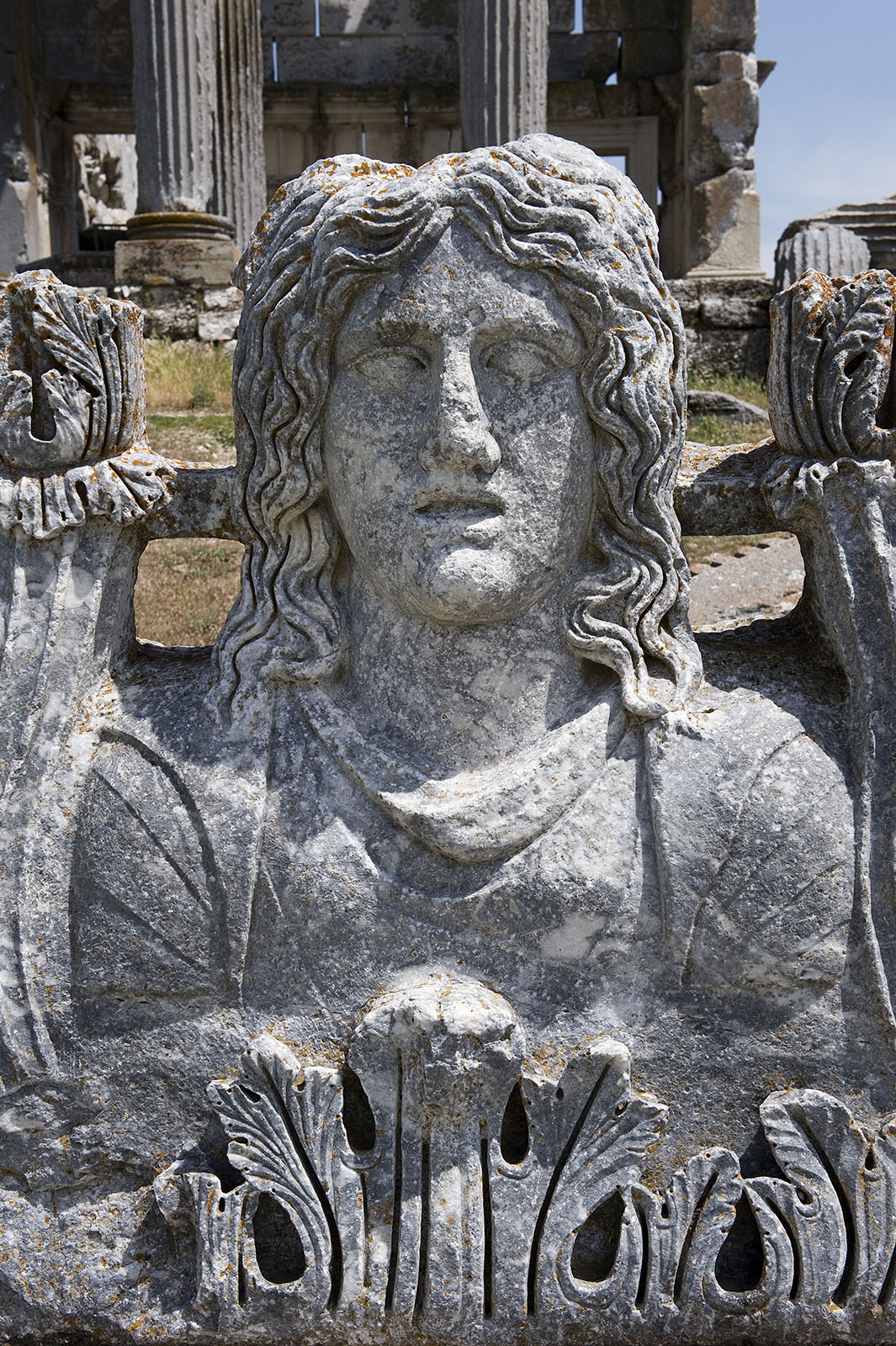|
Harpies
In Greek and Roman mythology, a harpy (plural harpies, , ; ) is a half-human and half-bird mythical creature, often believed to be a personification of storm winds. They feature in Homeric poems. Descriptions Harpies were generally depicted as birds with the heads of maidens, faces pale with hunger and long claws on their hands. Roman and Byzantine writers detailed their ugliness. Pottery art depicting the harpies featured beautiful women with wings. Ovid described them as human-vultures. Hesiod To Hesiod, they were imagined as fair-locked and winged maidens, who flew as fast as the wind: Aeschylus Even as early as the time of Aeschylus, harpies were thought to be ugly creatures with wings, and later writers carried their notions of the harpies so far as to represent them as most disgusting monsters. The Pythian priestess of Apollo compares the appearance of the Erinyes, chthonic goddesses of vengeance, with those of harpies in the following lines of The Eumenides: Vi ... [...More Info...] [...Related Items...] OR: [Wikipedia] [Google] [Baidu] |
Phineus
In Greek mythology, Phineus (; ), was a king of Salmydessus in Thrace and seer, who appears in accounts of the Argonauts' voyage. Some accounts make him a king in PaphlagoniaScholia on Apollonius of Rhodes, 2.178, 237; Scholia ''ad eund'' 2.177; Eustathius ad Homer, ''Iliad'2.851 ad Dionysius Periegetes, 787; Stephanus of Byzantium, s.v.; Constantine Porphyrogennetos, ''De thematibus'' 1.7; William Smith, '' Dictionary of Greek and Roman Geography'' s.v. Paphlagonia' or in Arcadia. Family Several different versions of Phineus's parentage were presented in ancient texts. According to Apollonius of Rhodes, he was a son of Agenor, but the '' Bibliotheca'' says that other authors named his father as Poseidon (who is the father of Agenor).Apollodorus1.9.21/ref> The Hesiodic ''Catalogue of Women'', on the other hand, reported that Phineus was the son of Phoenix and Cassiopeia. His first wife was Cleopatra, daughter of Boreas and Oreithyia, by whom he had a pair of son ... [...More Info...] [...Related Items...] OR: [Wikipedia] [Google] [Baidu] |
Hybrid (mythology)
Hybrid beasts are creatures composed of parts from different animals, including humans, appearing in the folklore of a variety of cultures as legendary creatures. In burial sites Remains similar to those of mythological hybrids have been found in burial sites discovered by archaeologists. Known combinations include horse-cows, sheep- cows, and a six-legged sheep. The skeletons were formed by ancient peoples who joined together body parts from animal carcasses of different species. The practice is believed to have been done as an offering to their gods. Description These forms' motifs appear across cultures in many mythologies around the world. Such hybrids can be classified as partly human hybrids (such as mermaids or centaurs) or non-human hybrids combining two or more non-human animal species (such as the griffin or the chimera). Hybrids often originate as zoomorphic deities who, over time, are given an anthropomorphic aspect. Paleolithic Partly human hybrids appear ... [...More Info...] [...Related Items...] OR: [Wikipedia] [Google] [Baidu] |
Heraldry
Heraldry is a discipline relating to the design, display and study of armorial bearings (known as armory), as well as related disciplines, such as vexillology, together with the study of ceremony, Imperial, royal and noble ranks, rank and genealogy, pedigree. Armory, the best-known branch of heraldry, concerns the design and transmission of the Achievement (heraldry), heraldic achievement. The achievement, or armorial bearings usually includes a coat of arms on a escutcheon (heraldry), shield, helmet (heraldry), helmet and Crest (heraldry), crest, together with any accompanying devices, such as supporters, Heraldic badge, badges, Heraldic flag, heraldic banners and mottoes. Although the use of various devices to signify individuals and groups goes back to Ancient history, antiquity, both the form and use of such devices varied widely, as the concept of regular, hereditary designs, constituting the distinguishing feature of heraldry, did not develop until the High Middle Ages. It i ... [...More Info...] [...Related Items...] OR: [Wikipedia] [Google] [Baidu] |
Lycophron
Lycophron ( ; ; born about 330–325 BC) was a Hellenistic Greek tragic poet, grammarian, and commentator on comedy, to whom the poem ''Alexandra'' is attributed (perhaps falsely). Life and miscellaneous works He was born at Chalcis in Euboea, and flourished at Alexandria in the time of Ptolemy Philadelphus (285–247 BC). According to the ''Suda'', the massive tenth century Byzantine Greek historical encyclopaedia, he was the son of Socles, but was adopted by Lycus of Rhegium. It is believed that Lycophron was acquaintances with Greek philosopher Menedemus, who may have influenced some of Lycophron's tragedies and even wrote a satyr drama about the man. At an unknown date Lycophron was intrigued by the literary movement in Alexandria and settled there. He was entrusted by Ptolemy with the task of arranging the comedies in the Library of Alexandria; as the result of his labours he composed a treatise ''On Comedy''. Lycophron is also said to have been a skillful writer of anagra ... [...More Info...] [...Related Items...] OR: [Wikipedia] [Google] [Baidu] |
Adrian Room
Adrian Richard West Room (27 September 1933, Melksham – 6 November 2010, Stamford, Lincolnshire, Stamford, Lincolnshire)''Contemporary Authors Online'', Gale, 2002; accessed 20 May 2013. was a British toponymist and onomastician, a Fellow of the Royal Geographical Society and a prolific author of reference works relating primarily to the origins of words and place-names. Between 1952 and 1979, Room served in the Royal Naval Reserve, Special Branch, retiring as a lieutenant commander. Before becoming a full-time author, he was employed at King's College School, Cambridge, where he taught modern languages and was a senior house master. He later, until 1984, worked as a senior lecturer in Russian for the Ministry of Defence (United Kingdom), Ministry of Defence. Selected publications *''Place-Names of the World''. London: Routledge & Kegan Paul, 1974. *''Place-name changes since 1900: A world gazetteer''. London: Routledge & Kegan Paul, 1980. *''Naming Names: Stories of Pseudo ... [...More Info...] [...Related Items...] OR: [Wikipedia] [Google] [Baidu] |
Oresteia
The ''Oresteia'' () is a trilogy of Greek tragedies written by Aeschylus in the 5th century BC, concerning the murder of Agamemnon by Clytemnestra, the murder of Clytemnestra by Orestes, the trial of Orestes, the end of the curse on the House of Atreus and the pacification of the Furies (also called Erinyes or Eumenides). The ''Oresteia'' trilogy consists of three plays: ''Agamemnon'', ''The Libation Bearers'', and ''The Eumenides''. It shows how the Greek gods interacted with the characters and influenced their decisions pertaining to events and disputes. The only extant example of an ancient Greek theatre trilogy, the ''Oresteia'' won first prize at the Dionysia festival in 458 BC. The principal themes of the trilogy include the contrast between revenge and justice, as well as the transition from personal vendetta to organized litigation. ''Oresteia'' originally included a satyr play, ''Proteus'' (), following the tragic trilogy, but all except a single line of ''Proteus' ... [...More Info...] [...Related Items...] OR: [Wikipedia] [Google] [Baidu] |
Erinyes
The Erinyes ( ; , ), also known as the Eumenides (, the "Gracious ones"), are chthonic goddesses of vengeance in ancient Greek religion and mythology. A formulaic oath in the ''Iliad'' invokes them as "the Erinyes, that under earth take vengeance on men, whosoever hath sworn a false oath". Walter Burkert suggests that they are "an embodiment of the act of self-cursing contained in the oath". Their Roman counterparts are the Furies, also known as the Dirae. The Roman writer Maurus Servius Honoratus ( AD) wrote that they are called "Eumenides" in hell, "Furiae" on Earth, and "Dirae" in heaven. Erinyes are akin to some other Greek deities, called Poenai. According to Hesiod's '' Theogony'', when the Titan Cronus castrated his father, Uranus, and threw his genitalia into the sea, the Erinyes (along with the Giants and the Meliae) emerged from the drops of blood which fell on the Earth ( Gaia), while Aphrodite was born from the crests of sea foam. Apollodorus also re ... [...More Info...] [...Related Items...] OR: [Wikipedia] [Google] [Baidu] |
Apollo
Apollo is one of the Twelve Olympians, Olympian deities in Ancient Greek religion, ancient Greek and Ancient Roman religion, Roman religion and Greek mythology, Greek and Roman mythology. Apollo has been recognized as a god of archery, music and dance, truth and prophecy, healing and diseases, the Sun and light, poetry, and more. One of the most important and complex of the Greek gods, he is the son of Zeus and Leto, and the twin brother of Artemis, goddess of the hunt. He is considered to be the most beautiful god and is represented as the ideal of the ''kouros'' (ephebe, or a beardless, athletic youth). Apollo is known in Greek-influenced Etruscan mythology as ''Apulu''. As the patron deity of Delphi (''Apollo Pythios''), Apollo is an oracular god—the prophetic deity of the Pythia, Delphic Oracle and also the deity of ritual purification. His oracles were often consulted for guidance in various matters. He was in general seen as the god who affords help and wards off e ... [...More Info...] [...Related Items...] OR: [Wikipedia] [Google] [Baidu] |
Sibyl
The sibyls were prophetesses or oracles in Ancient Greece. The sibyls prophet, prophesied at holy sites. A sibyl at Delphi has been dated to as early as the eleventh century BC by Pausanias (geographer), PausaniasPausanias 10.12.1 when he described local traditions in his writings from the second century AD. At first, there appears to have been only a single sibyl. By the fourth century BC, there appear to have been at least three more, Phrygian Sibyl, Phrygian, Erythraean Sibyl, Erythraean, and Hellespontine Sibyl, Hellespontine. By the first century BC, there were at least ten sibyls, located in Greece, ancient Italy, Italy, the Levant, and Asia Minor. History The English word ''sibyl'' () is from Middle English, via the Old French and the Latin from the ancient Greek (). Varro derived the name from an Aeolic Greek, Aeolic ''sioboulla'', the equivalent of Attic ''theobule'' ("divine counsel"). This etymology is not accepted in modern handbooks, which list the origin as ... [...More Info...] [...Related Items...] OR: [Wikipedia] [Google] [Baidu] |
Aeschylus
Aeschylus (, ; ; /524 – /455 BC) was an ancient Greece, ancient Greek Greek tragedy, tragedian often described as the father of tragedy. Academic knowledge of the genre begins with his work, and understanding of earlier Greek tragedy is largely based on inferences made from reading his surviving plays. According to Aristotle, he expanded the number of characters in the theatre and allowed conflict among them. Formerly, characters interacted only with the Greek chorus, chorus.The remnant of a commemorative inscription, dated to the 3rd century BC, lists four, possibly eight, dramatic poets (probably including Choerilus, Phrynichus, and Pratinas) who had won Dionysia#Known winners of the City Dionysia, tragic victories at the Dionysia before Aeschylus had. Thespis was traditionally regarded the inventor of tragedy. According to another tradition, tragedy was established in Athens in the late 530s BC, but that may simply reflect an absence of records. Major innovations in dramatic ... [...More Info...] [...Related Items...] OR: [Wikipedia] [Google] [Baidu] |
Hesiod
Hesiod ( or ; ''Hēsíodos''; ) was an ancient Greece, Greek poet generally thought to have been active between 750 and 650 BC, around the same time as Homer.M. L. West, ''Hesiod: Theogony'', Oxford University Press (1966), p. 40.Jasper Griffin, "Greek Myth and Hesiod", J.Boardman, J.Griffin and O. Murray (eds.), ''The Oxford History of the Classical World'', Oxford University Press (1986), p. 88. Several of Hesiod's works have survived in their entirety. Among these are ''Theogony'', which tells the origins of the gods, their lineages, and the events that led to Zeus's rise to power, and ''Works and Days'', a poem that describes the five Ages of Man, offers advice and wisdom, and includes myths such as Pandora's box. Hesiod is generally regarded by Western authors as 'the first written poet in the Western tradition to regard himself as an individual persona with an active role to play in his subject.' Ancient authors credited Hesiod and Homer with establishing Greek relig ... [...More Info...] [...Related Items...] OR: [Wikipedia] [Google] [Baidu] |
Vulture
A vulture is a bird of prey that scavenges on carrion. There are 23 extant species of vulture (including condors). Old World vultures include 16 living species native to Europe, Africa, and Asia; New World vultures are restricted to North and South America and consist of seven identified species, all belonging to the Cathartidae family. A particular characteristic of many vultures is a bald, unfeathered head. This bare skin is thought to keep the head clean when feeding, and also plays an important role in thermoregulation. Vultures have been observed to hunch their bodies and tuck in their heads in the cold, and open their wings and stretch their necks in the heat. They also urinate on themselves as a means of cooling their bodies. A group of vultures in flight is called a "kettle", while the term "committee" refers to a group of vultures resting on the ground or in trees. A group of vultures that are feeding is termed a "wake". Taxonomy Although New World vulture ... [...More Info...] [...Related Items...] OR: [Wikipedia] [Google] [Baidu] |









